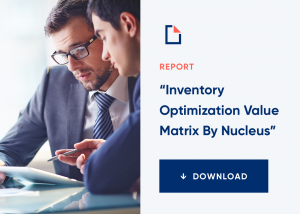Nucleus Pinpoints Inventory Optimization Trends and Solution Providers
The Nucleus Research Inventory Optimization (IO) Value Matrix report was just released, identifying the latest inventory optimization trends, top inventory optimization solution providers, and the strengths and weaknesses of each solution provider.
Nucleus positioned 17 vendors in its value matrix by analyzing end-user experiences relating to software usability and functionality. The matrix is divided into quadrants: Leaders, Experts, Facilitators, and Core Providers. The companies analyzed, in alphabetical order, are 4R Systems, Blue Ridge, E2open, GAINSystems, Infor, JDA Software, Kinaxis, Llamasoft, Logility, Manhattan Associates, One Network, Oracle, SAP, Slimstock, Smart Software, ToolsGroup, and Vanguard.
The Nucleus report identifies “Leaders” as those vendors that Nucleus Research rates as likely to deliver the greatest potential return on investment to their customers. Their solutions are “delivering value to customers with better visualizations, greater automation and machine learning capabilities, and more accurate forecasts.” That’s a tall order Nucleus says, but the leading IO vendors fill it with solutions that model inventory across multiple echelons (MEIO) of customer supply chains—with the flexibility to center business strategy around things like safety stock, service level, budgetary constraints, profit margin, and holding capacity.
Inventory Optimization Trends Defining the Industry
A continuous data model is crucial, he says. “With a single data model, users can immediately see the effect of a proposed change on every part of the supply chain and relevant KPIs,” the report emphasized. The leading vendors also optimize based on SKU service levels by individual SKU-Location.
A new theme this year is cutting planner workload by moving toward more autonomous inventory optimization and supply chain planning. Vendors are helping customers visualize and communicate how IO engines generate recommendations via dashboards with analytics and exceptions, report builders, and modeling tools. These help users understand the “why” for the suggested change, encourage stakeholder collaboration, and highlight the trade-offs of any action.
Vendors are also embedding more machine learning in supply chain solutions—to generate accurate demand forecasts for product launches or seasonal demand, as well as automatically find the correct optimization model for each SKU based on past sales performance and changing demand patterns. “As demand-driven supply chains become more standard, the power and quality of advanced machine learning capabilities will become a differentiator for companies that deploy them,” the report said. “The leading vendors in the 2017 IO Value Matrix are already leveraging machine learning techniques to account for variability in actual demand across the supply chain.”
Nucleus said firms are realizing value from IO solutions mated with demand sensing, replenishment planning, and sales and operations planning (S&OP)—yet stressed that best-of-breed vendors “… deliver value and are competitive in a marketplace which typically highlights end-to-end solutions.”
The report also includes a quick primer on the distinction between IO and inventory management. The latter controls existing inventory, while IO solutions “link a company’s level of inventory and where it is being held to how well it can service customer needs and what the financial cost is to the organization.” Nucleus calls inventory optimization solutions a “key lever” to help organizations run lean yet meet customer service levels targets and free working capital.







